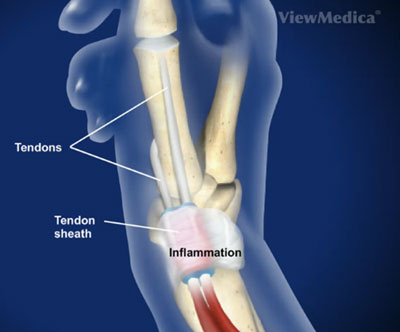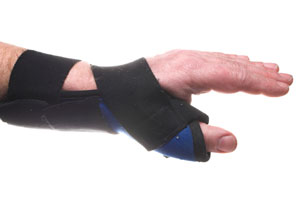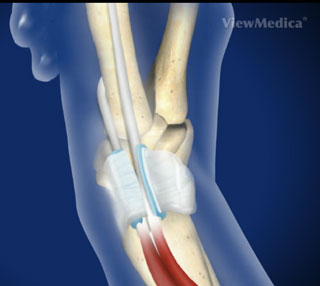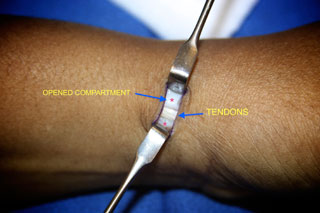Mommy Thumb – de Quervain’s Stenosing Tenosynovitis
What is Mommy Thumb (de Quervain’s Stenosing Tenosynovitis)?
There are tendons that run along the thumb side of the wrist that course through a small compartment adjacent to the forearm bone, radius, that function by extending or pulling the thumb outward. These tendons are covered by tissue, tenosynovium, that bathes the tendon with a lubricant that facilitates gliding of the tendon through this tight space.
Tendons are thick, rope-like structures that connect bone to muscles to allow movement. The synovium is a thin, slippery layer of soft tissue that covers the tendons allowing then to easily glide through the fibrous tendon sheath. The extensor pollicis brevis and the abductor pollicis longus tendons assist in pulling the thumb away from the palm. As these tendons move into the wrist they pass through a tunnel called the first dorsal compartment.
With repetitive use of the thumb or in some cases a specific injury, an increase in inflammatory tissue develops which reduces the space within this compartment leading to an increase in tendon friction which causes pain. De Quervain’s Tenosynovitis occurs when the lining of this sheath thickens, constricting the tendons.
For decades people have been afflicted with this condition, known as de Quervain’s tendonitis. In recent years with the development of PDA’s or small electronic devices that allow frequent data input in the palm of the hand for texting or emails, this condition has been referred to as “Blackberry Thumb”.
Recently, this condition has been showing up more and more in mothers with newborns and is now being called “Mommy Thumb”.

What causes mommy thumb?
 Mommy thumb may develop in the last trimester of pregnancy when mothers typically retain fluid which can lead to swelling within compartments in the hand and wrist. The most common condition affecting the hand and wrist during pregnancy is carpal tunnel syndrome. Usually these conditions resolve after pregnancy as swelling subsides.
Mommy thumb may develop in the last trimester of pregnancy when mothers typically retain fluid which can lead to swelling within compartments in the hand and wrist. The most common condition affecting the hand and wrist during pregnancy is carpal tunnel syndrome. Usually these conditions resolve after pregnancy as swelling subsides.
Mommy thumb usually develops after delivery over the first year of the newborn’s life from forceful or repetitive grasping of the infant while lifting the infant up or frequently carrying the infant. I am also seeing more and more mothers with this condition that are breast feeding and holding their wrist in an awkward position while cupping the breast.
As with many disorders of the hand and wrist, De Quervain’s Stenosing Tenosynovitis is commonly caused by repetitive use, trauma, or any other process that can cause inflammation. De Quervain’s Tenosynovitis is commonly called “Mommy’s thumb” since it is 10 times more common in women, and activities such as lifting gardening pots, groceries, and small children into car seats can inflict symptoms.
Add a blackberry or an iphone use to a nursing mother, places the mother at significant risk of developing mommy thumb.
What are symptoms of mommy thumb?
Pain at the thumb side of the wrist increased with thumb or wrist flexion or extension. Pain may radiate to the top of thumb or up the forearm. Swelling at the thumb side of wrist. May have a bump. May have tingling to top of hand. The primary symptoms are a result of inflammation and include pain, tenderness and swelling of the wrist below the thumb. As the condition progresses movement of the thumb may be reduced affecting grip.
How is De Quervain’s Stenosing Tenosynovitis diagnosed?
In addition to a complete history including activity, onset of pain, and symptoms the physician will also perform a physical examination. The Finkelstein maneuver is frequently used to help diagnose De Quervain’s Tenosynovitis. The thumb is doubled across the palm with the four fingers folded over grasping the thumb. If pain increases when the hand is contracted downward towards the wrist on the little finger side, then the test is considered positive.
Tenderness and swelling at the thumb side of wrist. Pain increased with resistance to thumb extension. Pain with clasping the thumb and bending the wrist towards the little finger side of wrist (Finklestein’s test). In severe cases, a grinding may be present at the thumb side of the wrist with thumb movement and thumb movement may be limited.
How is mommy thumb treated?
Non-surgical
 Initial treatment consists of resting the affected thumb for a period of about four weeks. The thumb and wrist are immobilized in a splint worn continuously, except when showering or washing hands. Ibuprofen or other NSAIDs (non-steroidal anti-inflammatory drugs) may be taken to reduce pain and inflammation. In some cases, a one-time cortisone injection may be administered to the first dorsal compartment to alleviate symptoms. Physical therapy and stretching in then used to restore range of motion. Unfortunately, 50% of cases require surgical intervention.
Initial treatment consists of resting the affected thumb for a period of about four weeks. The thumb and wrist are immobilized in a splint worn continuously, except when showering or washing hands. Ibuprofen or other NSAIDs (non-steroidal anti-inflammatory drugs) may be taken to reduce pain and inflammation. In some cases, a one-time cortisone injection may be administered to the first dorsal compartment to alleviate symptoms. Physical therapy and stretching in then used to restore range of motion. Unfortunately, 50% of cases require surgical intervention.
Surgical
In severe cases and those that do not respond to conservative treatment, a minimally invasive surgical release may be indicated. Decompression surgery relieves pressure on the affected tendons. A brace is worn for three days post-operatively, and then physical therapy is initiated. Overall recovery time is about 4-6 weeks.


How can Dr. Knight help you with mommy thumb?
Dr. Knight has over 25 years of experience in treating mommy thumb. While he cures most of these cases with conservative treatment, he has performed thousands of these procedures through minimally invasive techniques to minimize scarring and to return his patients back to an active lifestyle in no time.
If it is detected that you have de Quervain’s stenosing tenosynovitis, Dr. Knight will follow the standard, conservative treatment regimen, starting with NSAIDs and, if necessary, going as far as a surgery to release the pressure. The primary concern is to relieve your pain and allow you to return to your life and work with full functionality in your hands.
Dr. Knight is excited to be serving residents throughout the Dallas area. He’s best hand surgeons in Dallas and if anyone can help, he can. Come to our Dallas office or Southlake hand and wrist center at your convenience.
de Quervain’s Stenosing Tenosynovitis Fact Sheet
| What is de Quervain's tenosynovitis? | The condition is caused by repeptitive motion or trauma to the tendons of the wrist, and is often called Mommy Thumb or Blackberry Thumb, due to its commonness in association with those activities. |
| How can I treat de Quervain's at home? | Non-surgical treatment involves splinting and medication, including NSAIDs and ibuprofen can be used to alleviate pain. |
| Are there any medications that can be used to treat de Quervains? | In addition to the pain-relief and anti-inflammatory medications above, steroid injections may help to alleviate symptoms. These corticosteroids act as both anti-inflammatory agents and reduce pain and discomfort, but will not ultimatley heal the injury, so other forms of treatment are required. |
| What kind of long term effects does de Quervain's have? | When treated, de Quervains Tenosynovitis is easily reversed by physician, but if left untreated it can develop greatly and even result in a burst tendon sheath. |
| How can my de Quervain's be treated? | Advanced cases may require surgery, but this is usually only if the condition has gone untreated for a long time. |
Frequently Asked Questions:
What is a Finkelstein’s Test?
A Finkelstein’s Test is the best way to ascertain whether you suffer from de Quervain’s stenosing tenosynovitis or not. In this test, the doctor will have you fold your thumb down and across the palm of your hand, then close your fingers around your thumb. Once your hand is in this position, you will bend your fist down towards the ulnar aspect of the arm, and if this hurt, then you almost certainly suffer from de Quervain’s stenosing tenosynovitis.
What causes de Quervain’s Stenosing Tenosynovitis?
Just like so many other wrist problems, de Quervain’s stenosing tenosynovitis is often caused by overuse of the wrist, particularly repetitive motion, such as those activities relating to work or hobbies that require such motions. Arthritis can also lead to inflammation, which can cause the condition as well, and scar tissue from traumatic injuries may also be a precursor to the development of de Quervain’s. This condition is also commonly known as either Mommy Thumb or Blackberry Thumb, because mothers of young children and people who habitually use smartphones are common sufferers of the condition. The latter condition can develop during pregnancy, and then after birth, the constant grabbing and lifting of an infant very strongly affects the connective tissues of the hand and thumb and so it aggravates the already nascent condition and can turn it into full-blown de Quervain’s stenosing tenosynovitis. Constant text-messaging, which is a very common habit among people of all ages these days, can also cause the condition, depending on how the phone is held in the hand and which fingers are used for typing. Ironically, when the phone is held “correctly” and the “correct” fingers are used to type, you are actually MORE likely to develop the condition than someone who types atypically.
Is de Quervain’s Stenosing Tenosynovitis permanent?
When it is effectively and efficiently treated by a physician, de Quervain’s stenosing tenosynovitis is easily reversable, and the effects will lessen and eventually disappear completely. If, however, the condition goes untreated for some time, the damage caused to the tendon sheath can be permanent and cause pain and discomfort, as well as limiting range of motion. In extreme cases, the tendon sheath may even burst due to intense inflammation and damage to the tissue.
Does de Quervain’s Stenosing Tenosynovitis require treatment, or can it go away on its own?
de Quervain’s stenosing tenosynovitis will not resolve on its own. While it is possible to treat the onset of the condition and its precursors with modification of activity, rest, ice, and some anti-inflammatory medications, once it sets in it is necessary for you to seek treatment from a medical professional to treat it. If left alone, as mentioned above, the consequences can be severe, and can range from severe discomfort to a burst tendon sheath, which would then, obviously, require additional and lengthy treatment and surgery to remedy.
Surgical Videos
Note: The following videos contain graphic images.
Animated Videos
(817) 382-6789
Disclaimer
HandAndWristInstitute.com does not offer medical advice. The information presented here is offered for informational purposes only. Read Disclaimer

























